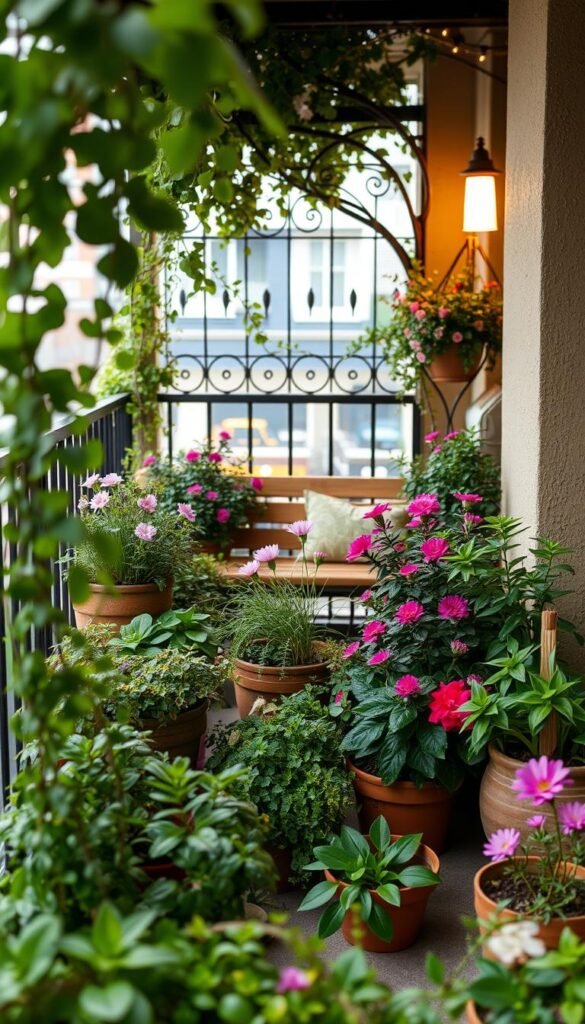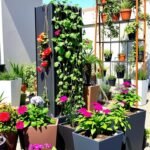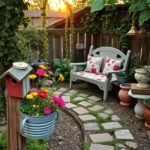Ever dreamed of growing fresh herbs, veggies, or flowers but think you lack the room? Think again. Your elevated outdoor area—whether it’s a cozy nook or a sunlit perch—can become a thriving green retreat. This guide walks you through five simple strategies to turn underused corners into vibrant, productive zones.
Nurturing plants isn’t just about aesthetics. Studies show tending greenery reduces stress and boosts mood. Imagine snipping basil for tonight’s pasta or plucking cherry tomatoes still warm from the sun. Those rewards are closer than you think, even in tight quarters.
You’ll learn how to maximize vertical surfaces, choose compact varieties, and arrange pots for easy care. We’ll also explore creative solutions like hanging planters and modular shelves. No expertise? No problem. These methods work whether you’re a first-timer or a seasoned grower.
Ready to breathe life into your urban oasis? Let’s dive into practical tips that balance functionality with beauty. By the end, you’ll have a clear roadmap to cultivate joy—and maybe even a salad—right outside your door.
Understanding the Benefits of Balcony Gardening
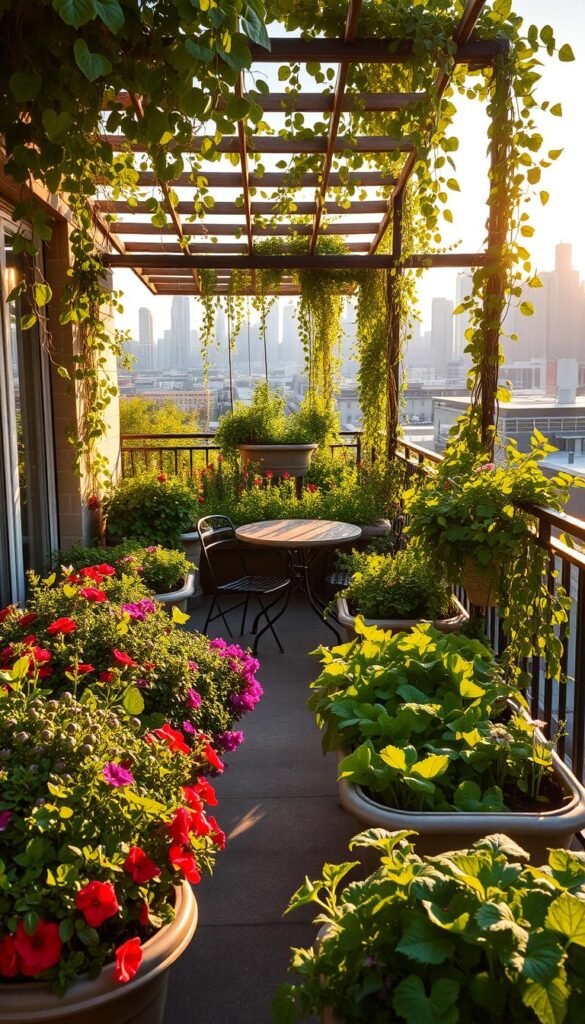
Did you know your elevated outdoor area can become a source of fresh meals and mental clarity? Nurturing plants in urban settings does more than beautify your view—it rewires your daily routine with purpose. Let’s explore why transforming this space pays dividends beyond greenery.
Mental and Physical Health Advantages
Tending plants lowers cortisol levels by up to 40%, according to University of Michigan research. Digging in soil, arranging pots, and watering regularly become gentle exercises. These tasks engage muscles you rarely use while scrolling or sitting.
Choosing compact herbs like basil or mint adds sensory joy. Their fragrances naturally reduce anxiety. Plus, watching seedlings grow teaches patience—a counterbalance to fast-paced city life.
Peace, Tranquility, and Fresh Produce
Your green corner becomes a meditation zone. Morning coffee surrounded by blooming flowers? Yes, please. Studies show just 20 minutes among plants daily sharpens focus and lifts moods.
Smart potting strategies matter. Self-watering containers prevent root rot. Pair them with nutrient-rich soil for plump tomatoes or crisp lettuce. Suddenly, your salads taste better because you grew the toppings.
| Benefit Type | Herbs | Flowers |
|---|---|---|
| Culinary Use | Basil, Thyme, Oregano | Edible blooms like Nasturtiums |
| Stress Reduction | Lavender, Lemon Balm | Chamomile, Marigolds |
| Air Quality | Rosemary, Mint | Geraniums, Petunias |
Whether snipping parsley for dinner or arranging zinnias in a vase, balcony gardening turns chores into cherished rituals. It’s not just about harvests—it’s about cultivating joy in every leaf.
Assessing Your Balcony’s Unique Conditions
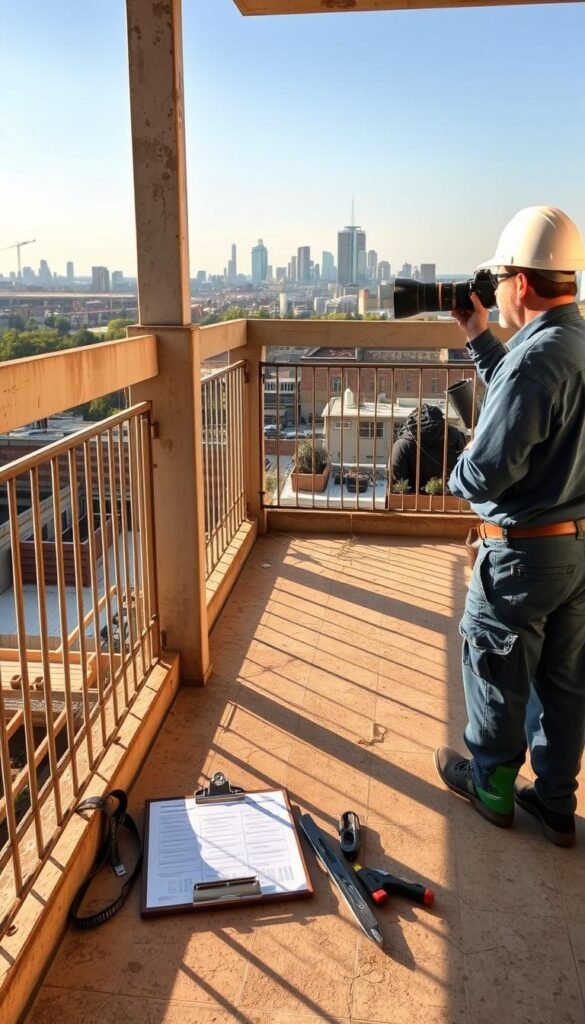
Before potting your first plant, take time to understand your elevated growing environment. Every space has distinct rules and physical limits that shape what thrives there. Let’s break down three critical factors to evaluate.
Checking Building Permissions and Guidelines
Start by reviewing your lease or condo rules. Many apartments restrict hanging planters or large pots for safety. A quick call to property management saves time and prevents fines later. Some buildings even offer approved container lists.
Evaluating Structural Load and Weight Limitations
Soil-filled containers get heavy—fast. A 24-inch ceramic pot with wet dirt can weigh 80+ pounds. Test weight limits using your building’s specs or consult an engineer. Opt for lightweight fiberglass or fabric planters if structural strength is questionable.
Monitoring Sunlight Exposure and Wind Patterns
Track how sunlight moves across your space over three days. Leafy greens like lettuce thrive with 4-6 hours of morning light, while tomatoes need 8+ hours. Use windbreaks like bamboo screens if gusts frequently topple plants. Adjust placements seasonally as sun angles shift.
Pro tip: Group vegetables with similar needs. Position shade-tolerant herbs under taller pots. This strategic approach maximizes yields without overcrowding your limited area.
Choosing the Right Containers and Potting Mix
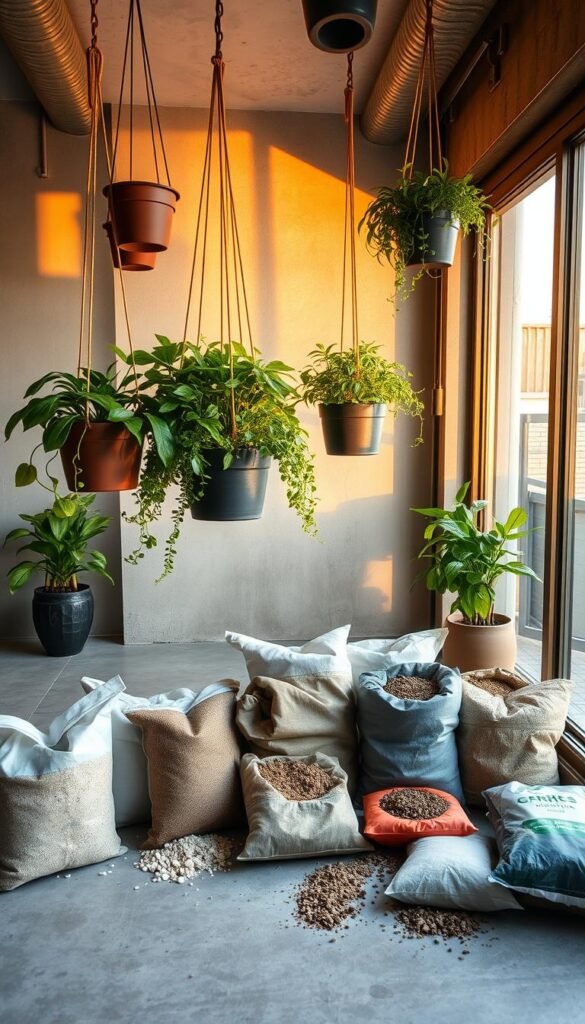
Your plant’s home matters just as much as sunlight and water. The perfect container-and-soil combo acts like a tailored suit: supportive but never restrictive. Let’s explore how to match your setup to your greens’ needs.
Types of Pots: Self-Watering, Fabric, and More
Self-watering pots are game-changers for busy urbanites. Their reservoirs provide steady moisture, ideal for thirsty spinach and lettuce. Fabric grow bags? They’re lightweight champions that air-prune roots naturally.
- Plastic tubs: Budget-friendly and lightweight
- Terracotta: Breathable but dries faster
- Hanging baskets: Save floor space for trailing herbs
Importance of Drainage and Soil Quality
Drainage holes aren’t optional—they’re lifesavers. Without them, water pools drown roots within days. Pair proper drainage with potting mix, not garden soil. Why? Mixes stay fluffy, resist compaction, and feed plants longer.
When growing leafy greens like spinach, the amount of soil matters. Shallow roots thrive in 6-8” depth, while tomatoes need 12”+. Test moisture by finger-probing—damp, not soggy, is the sweet spot.
Pro tip: Combine vertical planters for compact vegetables with floor pots. This layering maximizes yield without crowding your space. Remember: happy roots mean bountiful harvests!
Small Space Gardening on a Balcony: 5 Steps to Success
Transforming your elevated outdoor area into a lush retreat doesn’t require magic—just smart planning. Follow these five core principles to create a thriving green haven:
- Assess conditions like sunlight and wind patterns
- Select containers matching your space’s weight limits
- Use nutrient-rich soil for healthy plants grow
- Group species with similar care needs
- Adjust layouts seasonally for optimal growth
Understanding your balcony’s unique conditions lets you customize strategies. Bright spots? Try sun-loving cherry tomatoes. Shady corners? Impatiens burst with color without direct light. These adaptable blooms thrive in containers and add instant vibrancy.
Vertical gardening solves space crunches beautifully. Install wall-mounted planters for herbs or stack modular shelves for strawberries. This approach triples growing areas while keeping walkways clear. Pair these systems with strategic adjustments like rotating pots weekly for even sun exposure.
Balcony gardening succeeds through flexibility. Move sensitive plants indoors during heatwaves or storms using rolling carts. Track growth patterns—if basil outgrows its pot, transplant it into a deeper container. Small tweaks keep your green oasis thriving year-round.
Selecting Plants for Your Balcony Garden
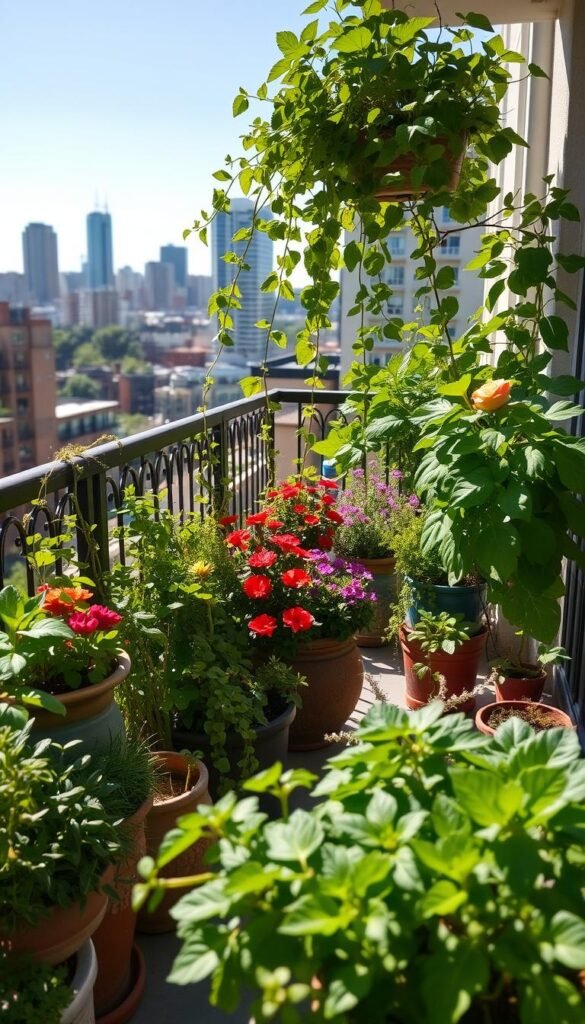
Curating the perfect plant palette transforms your elevated nook into a living masterpiece. The right choices balance beauty with practicality, thriving in your specific conditions while delighting the senses. Let’s explore how to match greenery to your unique setup.
Vegetables and Edibles in Compact Containers
Focus on dwarf varieties and shallow-rooted crops. Cherry tomatoes like ‘Tiny Tim’ yield pints of fruit in 12-inch pots. Peppers such as ‘Lunchbox Red’ add vibrant color while fitting narrow ledges. For leafy greens, try spinach or kale—they grow quickly and handle partial shade.
Herbs and Flowers That Thrive in Limited Light
Mint and parsley flourish with just 3-4 hours of morning sun. Pair them with coleus plants, whose patterned leaves brighten dim corners. For blooms, impatiens and begonias burst with color without direct light. Their lush foliage creates a tropical vibe even in north-facing spaces.
Benefits of Vertical and Hanging Plant Options
Wall-mounted planters turn blank surfaces into strawberry patches. Cascading herbs like thyme spill beautifully from suspended pots. Self-watering pots maintain consistent moisture for vertical gardens, reducing daily upkeep. This approach triples growing areas while keeping walkways clear.
Choose species that look as good as they taste. Variegated mint adds visual interest, while edible nasturtiums pepper salads with orange blossoms. Remember: a well-planned arrangement feeds both body and soul, proving even small spaces can yield big rewards.
Utilizing Vertical Gardening Techniques
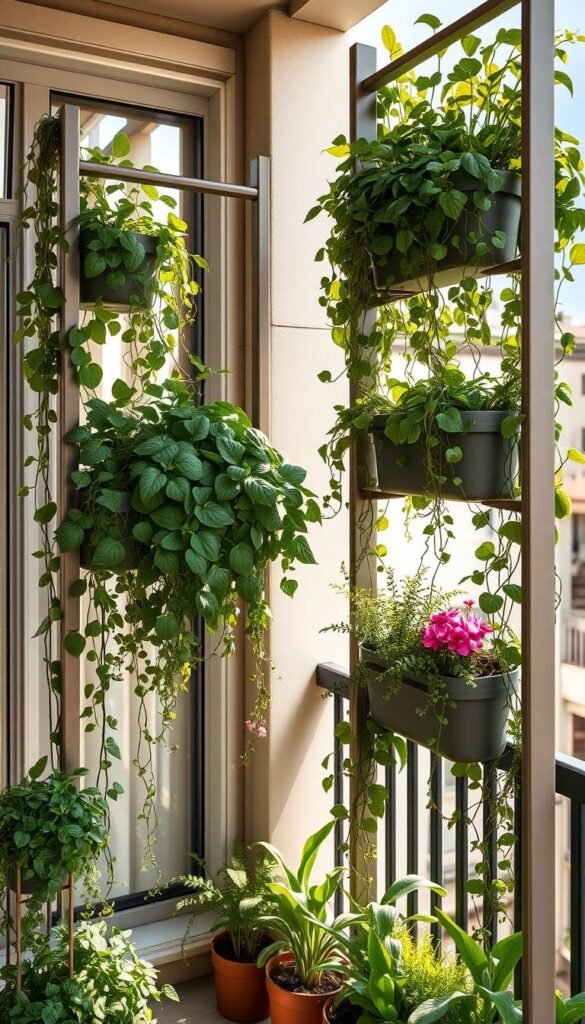
Elevate your harvest potential by looking up—literally. Walls and railings offer untapped real estate for greenery. Vertical systems transform cramped areas into lush jungles while keeping walkways clear. This approach works wonders for limited space, letting you grow more without sacrificing style.
Maximizing Space with Trellises and Railing Planters
Trellises turn blank walls into cucumber highways or bean jungles. Opt for foldable metal grids—they’re lightweight and adjustable. Attach them securely with outdoor-grade zip ties, then train vines upward. This method keeps plants organized and maximizes airflow.
Railing planters? They’re your balcony’s best friend. Use L-shaped brackets to hang boxes filled with strawberries or trailing nasturtiums. Choose shallow-rooted herbs like thyme to avoid overcrowding. Rotate pots weekly for even sun exposure.
Creative Installation Ideas for Vertical Growth
Try tiered shelves with cascading plants. Place tall species like snapdragons at the back, compact basil in front. For DIY flair, repurpose shoe organizers into pocket planters—perfect for lettuce or succulents. Label each pouch with chalk paint for a playful touch.
Maintain your setup by checking drainage holes monthly. Use moisture meters to prevent overwatering in stacked systems. Pair these hacks with the best plants for vertical growth: compact cherry tomatoes, dwarf sunflowers, or climbing peas. They’ll thrive while turning your balcony into a living tapestry.
Watering and Fertilizing Your Container Garden
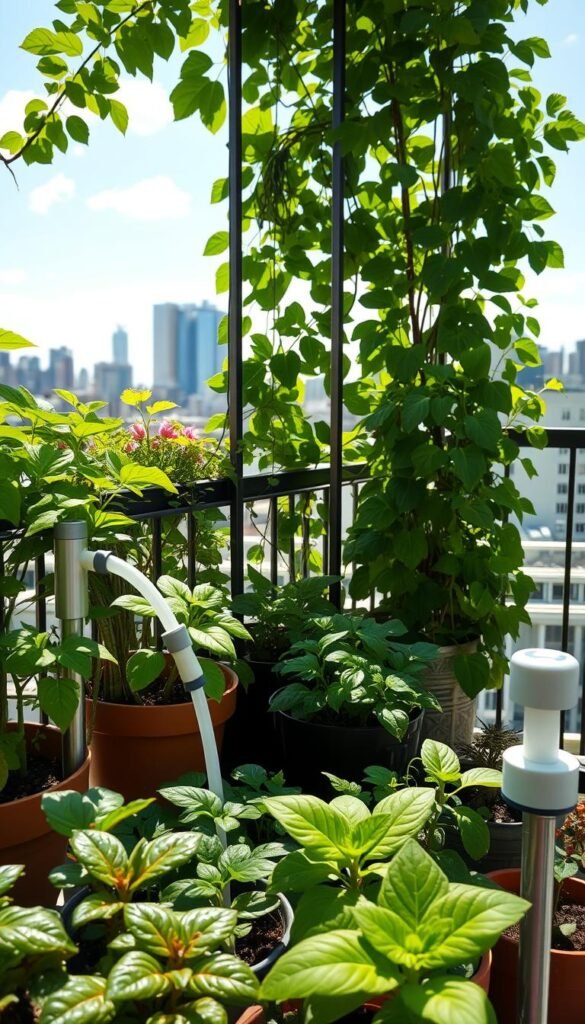
Water and nutrients are the lifeblood of your elevated green space. Getting these elements right means the difference between thriving greenery and wilted disappointment. Let’s explore systems and strategies that keep your pots productive.
Choosing the Right Watering System: Drip vs. Self-Watering
Drip irrigation delivers precise moisture through tubes—ideal for large setups with multiple containers. It’s customizable but requires installation. Self-watering pots? Their reservoirs wick water upward, perfect for forgetful gardeners or vacation weeks.
Consider your balcony’s size. Drip systems work best for 6+ pots, while self-watering units suit compact spaces. Both prevent overwatering, a common killer of container-grown plants.
Tips for Effective Fertilization and Plant Nutrition
Potting mix loses nutrients faster than garden soil. Replenish them with slow-release granules mixed into the top layer every 8 weeks. Liquid seaweed extract gives quick boosts during growth spurts.
Watch for yellow leaves—they often scream for nitrogen. A simple fix: dilute fish emulsion in water and apply at dawn. Always water before fertilizing to prevent root burn.
| Fertilizer Type | Best For | Frequency |
|---|---|---|
| Compost Tea | Leafy Greens | Every 2 Weeks |
| Balanced Granules | Flowering Plants | Monthly |
| Epsom Salt Spray | Tomatoes/Peppers | Biweekly |
Pair these methods with quality containers that drain well. Glazed ceramic pots retain moisture better than terracotta in windy balconies. Remember: consistent care turns limited spaces into lush, edible paradises.
Managing Pests and Plant Health
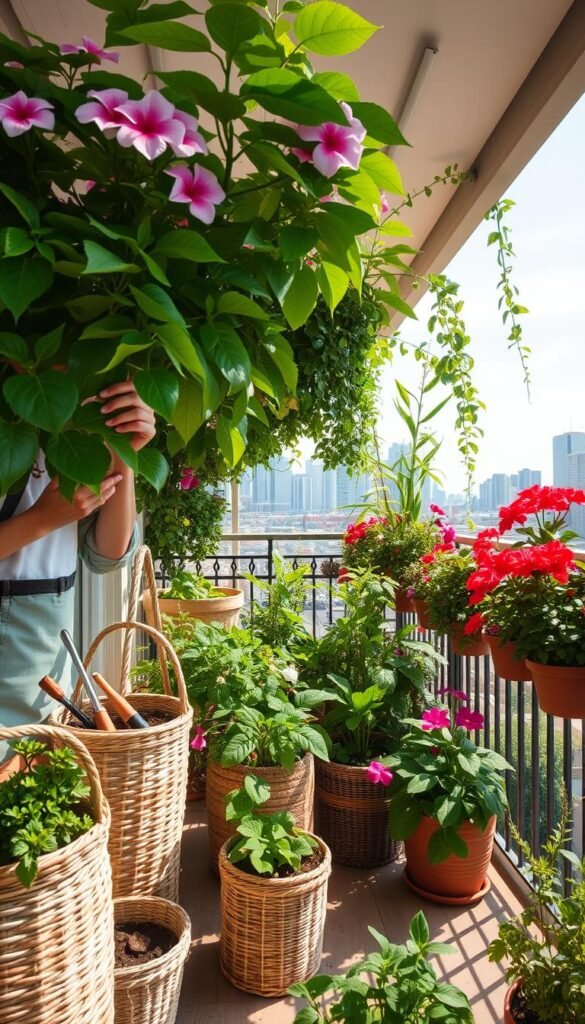
What’s nibbling your basil or turning leaves yellow? Even thriving container gardens face uninvited guests. In elevated spaces, early detection and smart strategies keep your greenery robust. Let’s tackle common intruders and organic solutions tailored for apartment living.
Identifying Common Pests on Balconies
Aphids cluster on new growth, leaving sticky residue. Spider mites create fine webs under leaves—wipe with a white cloth to spot them. Whiteflies swarm when disturbed, especially around tomatoes. Check container-grown greens daily; pests multiply fast in warm, sheltered spaces.
Organic Remedies and Preventative Measures
Blast bugs off with water before sunrise. Mix 1 tsp neem oil + 1 quart water for a weekly spray. Introduce ladybugs to devour aphids naturally. For persistent issues, sprinkle food-grade diatomaceous earth around container bases—it dehydrates pests without chemicals.
Apartment dwellers face unique challenges. Shared walls mean pests can travel between units. Quarantine new plants for 3 days before introducing them. Use trellises to improve airflow—damp foliage attracts fungi. Rotate pots to discourage nesting insects.
Pro tips: Inspect leaf undersides during morning checks. Yellow sticky traps catch flying adults. Wipe down railings and shelves monthly with vinegar to disrupt ant trails. Healthy plants resist invaders better—never overwater, and prune damaged leaves promptly.
Stay one step ahead. A quick daily scan takes seconds but saves weeks of recovery. With these tactics, your elevated oasis stays lush and productive all season.
Creative Design Ideas to Maximize Your Limited Space
Your balcony deserves more than just a few pots—it can become a curated display of living art. Thoughtful design elevates both beauty and efficiency, turning functional elements into style statements. Let’s explore how to blend aesthetics with practicality in your elevated oasis.
Selecting Color-Coordinated Containers
Match pots to your outdoor furniture or building’s exterior for a polished look. Soft terracotta complements brick walls, while cobalt blue makes leafy greens pop. Light-colored containers reflect the sun, keeping roots cooler in summer heat.
Incorporating Decorative Elements and Functional Design
Add personality with hand-painted trellises or mosaic-topped tables. Use decorative watering cans as centerpieces—they double as storage for gardening tools. Hang string lights above cascading plants to create evening ambiance while highlighting your greenery.
Mixing Planter Sizes for Visual Impact
Combine tall, narrow pots with wide bowls to create depth. Place sprawling cherry tomatoes in deep planters at the back, then layer mint and thyme in shallow front containers. This tiered approach maximizes light exposure and adds drama.
Try these clever ideas to merge form and function:
- Use self-watering wall planters shaped like geometric art
- Install foldable shelves that convert into plant stands
- Train vines along patterned wire grids as living curtains
Remember: every element should serve multiple purposes. A vintage ladder becomes vertical storage for herbs. Mirrors strategically placed bounce sun onto shade-loving plants. With creativity, even your watering routine becomes part of the design—try copper watering spikes that look like sculpture.
Wrapping Up Your Balcony Garden Journey
Your journey with container-grown greenery is just beginning. Each day offers fresh wins—whether it’s new sprouts or a pest-free harvest. Remember those early steps: assessing sunlight, choosing containers, and grouping plants wisely. These foundations keep your oasis thriving.
Stay vigilant about pests. A quick daily check under leaves prevents infestations. If aphids appear, neem oil works wonders. For deeper insights, explore solutions to common challenges that protect your hard work.
Every season brings surprises. Cooler months might mean swapping tomatoes for kale. Spring invites experiments with trailing flowers. Adaptability turns limitations into creative fuel. Need inspiration? Thriving green spaces start with curiosity, not perfection.
Celebrate growth—yours and your plants’. Share triumphs online or with neighbors. Those tiny leaves reaching for sunlight? They mirror your dedication. Keep nurturing, keep learning, and watch your elevated haven flourish.

